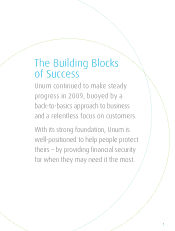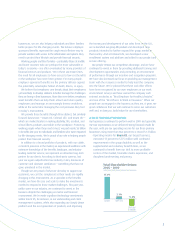Unum 2009 Annual Report Download - page 6
Download and view the complete annual report
Please find page 6 of the 2009 Unum annual report below. You can navigate through the pages in the report by either clicking on the pages listed below, or by using the keyword search tool below to find specific information within the annual report.
4
To Our Shareholders, Customers, and Colleagues: continued
$1.64
2005
$1.80
2006
$2.21
2007
$2.51
2008
$2.57
2009
Earnings Per Share*
(excluding special items)
*See the previous discussion of
non-GAAP financial measures
• Unum UK reported operating income of $250 million, a
decline from prior year results that was driven primarily
by lower premium income and continued weakening of
the exchange rate.
• Operating income at Colonial Life increased nearly five
percent to $281 million, with continued strong margins and
premium persistency, as well as strong new account growth.
The steps we’ve taken to diversify our business, take a more
disciplined approach to pricing and underwriting, and strengthen
our investment portfolio have served us extremely well. We have
not been completely immune to current economic pressures,
however. Premium income for the year was below our long-term
expectations as many of our existing customers experienced
lower employment levels which adversely impacted our premium
levels. Despite this pressure, I continue to be encouraged by
the underlying trends we’re seeing in new customer accounts
and persistency, both of which are positive signs that we continue
to have a strong value proposition and that we should see
premium growth resume when employment conditions improve.
Our investment portfolio once again performed well in 2009
with the quality remaining strong, which is quite an accomplishment
in this environment. Our emphasis on sound risk management in
our portfolio, including credit and interest rate management, has
positioned us well and generally reduced the volatility in our
results, while also avoiding exposure to the asset classes that became
a drain on capital and liquidity for others in our industry.
We also continued to build balance sheet strength and a
strong and flexible capital position in 2009. Our capital strength
is a valuable asset in today’s environment. With this, we were
one of the few insurance companies to receive a ratings upgrade
over the last year. While we will continue to take a conservative
approach to managing our capital in this environment, it is also
important to remember that we have a history of returning
capital to shareholders when appropriate, with a 10-percent
dividend increase last year preceded by a share repurchase
program the previous year. We will continue to manage our
capital in a way that supports the business and the needs of
all stakeholders.
Although our stock appreciated a modest seven percent
in 2009, which was slightly below our peers, our three- and
five-year total returns continue to outperform not only our peers
but also the broader S&P 500. Our goal is to continue to create
long-term shareholder value, and I remain convinced that we
will continue to do so by generating consistent, profitable
growth while maintaining a strong, flexible financial position.
A CULTURE OF RESPONSIBILITY
I maintained earlier that being viewed as a company that always
does the right thing is important, but never more so than at this
time. Today, that defines your “brand” perhaps more than
anything else, including financial results. Throughout its history,
Unum has fostered a culture of responsibility, starting with what
we do to serve our customers during their time of need and
extending to the role we play in our communities, the commitment
we have to protecting the environment, and the work we do
to foster cooperation between the public and private sector.
We strongly believe that high-performing companies can and
should take an active role in giving back to their communities, and
last year Unum donated more than $6.6 million to charitable
organizations throughout the U.S. and the U.K., including more than
$1.2 million of employee contributions through our matching gifts
program. In addition to giving generously, our employees also lent
countless hours of their time to thousands of needy organizations.
These benefit a wide array of organizations, with a special
focus on disabilities, health and wellness, the arts and, most
significantly, public education. In the past year alone, our
public education efforts have helped thousands of individuals
through organizations like South High Community School in
Worcester, Mass., the Boys & Girls Club of the Midlands in
Columbia, S.C., Principal Leadership Academy in Chattanooga,
Tenn., and Jobs for Maine’s Graduates.
We are also conscious of the environment in all that we do.
In 2009, we made further reductions in our carbon footprint by
recycling more than 3.3 million pounds of paper and cardboard,
adopting a green cleaning program and reducing our overall
electricity usage by more than nine percent — all of which



















